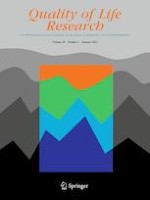20-08-2020
Validation of the WHOQOL-Bref instrument in Brazilian sign language (Libras)
Gepubliceerd in: Quality of Life Research | Uitgave 1/2021
Log in om toegang te krijgenAbstract
Purpose
The recognition of the Brazilian Sign Language (Libras) as the official language of the Brazilian deaf, in 2002, reaffirms the linguistic and cultural particularities of the deaf population. Therefore, there is a lack of a validated instrument for assessing the Quality of Life of deaf people using Libras. With authorization from the World Health Organization (WHO), a version of the WHOQOL-Bref in Libras was developed, called WHOQOL-Bref/Libras. However, its psychometric properties have not been examined as yet. Therefore, the purpose of this work is to perform the psychometric validation of the WHOQOL-Bref/Libras.
Methods
WHOQOL-Bref/Libras and a sociodemographic questionnaire were applied to 311 deaf people from the five Brazilian regions. To assess temporal stability, the questionnaire was readministered to 52 deaf people, over an interval of 2 weeks.
Results
WHOQOL-Bref/Libras demonstrated satisfactory psychometric values for reliability, discriminant and construct validity, temporal stability, and internal consistency. Cronbach’s alpha coefficient showed satisfactory values for each of the WHOQOL-Bref domains: Physical health (0.641), Psychological (0.705), Environment (0.710), and Overall-Bref domains (0.873). The WHOQOL-Bref/Libras is the appropriate option to assess the quality of life of deaf people who communicate through Libras.
Conclusion
WHOQOL-Bref/Libras had a satisfactory psychometric performance; therefore, it is a valid option that will provide autonomous participation for the deaf in quality of life investigations.
